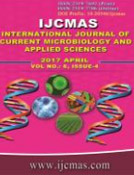


 National Academy of Agricultural Sciences (NAAS)
National Academy of Agricultural Sciences (NAAS)

|
PRINT ISSN : 2319-7692
Online ISSN : 2319-7706 Issues : 12 per year Publisher : Excellent Publishers Email : editorijcmas@gmail.com / submit@ijcmas.com Editor-in-chief: Dr.M.Prakash Index Copernicus ICV 2018: 95.39 NAAS RATING 2020: 5.38 |
Cultural, morphological and molecular characteristics of Fusarium oxysporum f. sp. ciceri, eight isolates indicated a great variability amongst them. However, the isolate FOC-2 (Jalna) exhibited maximum mycelial growth of 90.00 mm. The isolates viz., Jalna (FOC-2) and Beed (FOC-3) produced partially submerged (FOC-2) to submerged (FOC-3) white sparse dense growth with smooth margin and bright white substrate pigmentation. Maximum micro-conidial, macro-conidial and chlamydospore size (17.20 µm, 30.50 x 7.00 µm and 21.80 x 19.60 µm) was recorded in isolate Jalna (FOC-2). The micro-conidia were more or less oval to cylindrical with no septation. The macro-conidia were typically sickle shaped curved, fusoid varied in the size and number of septation (3-5). The chlamydospores were round to oval in shape. Genetic diversity was analyzed based on data obtained by 10 RAPD primers. Most of the primers were found 91.66 to 100 per cent polymorphic in nature. All primers had amplified total number of 144 bands among which 140 and 4 were found polymorphic and monomorphic, respectively. The cluster I comprised isolates FOC-1 (Aurangabad) and FOC-6 (Nanded) together and showed 57.60 per cent similarity to each other; however, cluster II comprised six isolates [FOC-2 (Jalna), FOC-3 (Beed), FOC-4 (Osmanabad), FOC-5 (Latur), FOC-7 (Parbhani) and FOC-8 (Hingoli)] together showing 53.88 per cent similarity. All of these six isolates of cluster II were from different region showing maximum similarity in the range of 59.00 to 100 per cent.
 |
 |
 |
 |
 |